Fiches poissons (page 35)
Page 35 des 2657 espèces de Poissons avec 60 fiches. Il y a 18 genres différents de Pimelodus à Pomacentrus.
Liste des fiches de Pimelodus tetramerus à Pomacentrus adelus
- Pimelodus tetramerus
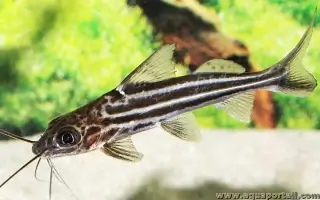 Bagre à 4 lignes
Bagre à 4 lignes
14,0 → 18,0 cm (> 450 L)
pH 6,0–7,5 | GH 5–12 | 21–26°C - Pimephales notatus
 Méné ventre-pourri, méné à museau arrondi
Méné ventre-pourri, méné à museau arrondi
6,0 → 11,0 cm (> 200 L)
pH 6,0–7,5 | GH 3–12 | 0–33°C - Pimephales promelas
 Tête-de-boule
Tête-de-boule
7,0 → 11,0 cm (> 200 L)
pH 6,5–7,5 | GH 5–15 | 10–21°C - Placidochromis electra

12,0 → 17,0 cm (> 450 L)
pH 7,5–8,5 | GH 10–30 | 24–26°C - Plagiotremus rhinorhynchos
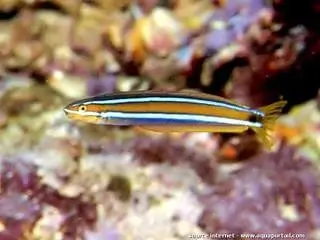 Blennie à dents de sabre à rayure bleue
Blennie à dents de sabre à rayure bleue
10,0 → 12,0 cm (> 300 L)
pH | GH | 23–28°C - Plagiotremus tapeinosoma
 Blennie à dents acérées
Blennie à dents acérées
12,0 → 14,0 cm (> L)
pH | GH | 23–28°C
- Planiloricaria cryptodon

18,0 → 22,0 cm (> 450 L)
pH 6,0–7,5 | GH 3–8 | 22–28°C - Plataplochilus oslislyensis

5,0 → 5,5 cm (> 80 L)
pH 7,0–8,0 | GH 10–30 | 20–25°C - Plataplochilus terveri

3,5 → 4,5 cm (> 120 L)
pH 6,5–7,5 | GH 5–12 | 18–22°C - Platax orbicularis

40,0 → 60,0 cm (> 1500 L)
pH 8,0–8,5 | GH | 23–28°C - Platax pinnatus
 Platax à nageoires jaunes
Platax à nageoires jaunes
35,0 → 45,0 cm (> 800 L)
pH 8,0–8,5 | GH | 23–28°C - Platax teira
 Platax à longues nageoires
Platax à longues nageoires
40,0 → 70,0 cm (> 1500 L)
pH 8,0–8,5 | GH | 23–28°C - Platydoras armatulus
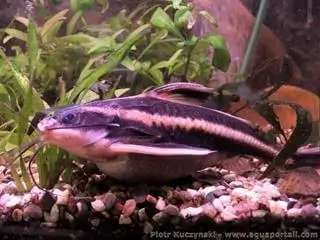 Silure rayé de Raphaël
Silure rayé de Raphaël
16,0 → 20,0 cm (> 300 L)
pH 5,5–7,5 | GH 2–20 | 23–29°C - Platydoras costatus
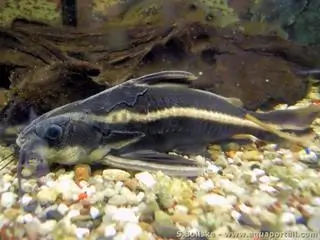 Silure rayé
Silure rayé
20,0 → 24,0 cm (> 300 L)
pH 5,5–7,0 | GH 3–15 | 24–30°C - Platydoras hancockii
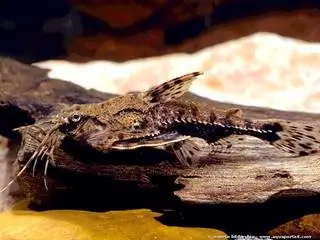 Poisson-chat aux yeux bleus, Doras d'Hancock
Poisson-chat aux yeux bleus, Doras d'Hancock
12,0 → 16,0 cm (> 200 L)
pH 6,0–8,0 | GH 5–20 | 23–28°C - Plectorhinchus chaetodonoides
 Plectorhinque chétodonoïde
Plectorhinque chétodonoïde
50,0 → 75,0 cm (> L)
pH 8,0–8,5 | GH | 23–28°C - Plectorhinchus vittatus
 Gaterin oriental, Peau d'âne, Gaterin bagnard
Gaterin oriental, Peau d'âne, Gaterin bagnard
60,0 → 85,0 cm (> 1500 L)
pH 8,0–8,5 | GH | 23–28°C - Pleurosicya mossambica
 Gobie nain du Mozambique
Gobie nain du Mozambique
2,6 → 3,3 cm (> 50 L)
pH 8,0–8,5 | GH | 23–28°C - Plotosus lineatus
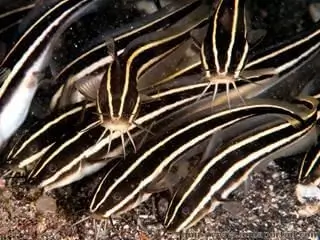 Poisson-chat de mer rayé, Balibot rayé
Poisson-chat de mer rayé, Balibot rayé
25,0 → 30,0 cm (> 1500 L)
pH 8,0–8,5 | GH | 23–28°C - Poecilia amazonica
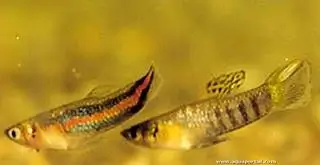
2,5 → 4,0 cm (> 20 L)
pH 7,0–7,5 | GH 5–10 | 24–28°C - Poecilia boesemani
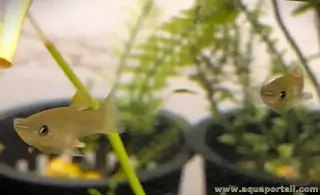
3,0 → 4,0 cm (> 80 L)
pH 7,0–7,5 | GH 8–15 | 24–28°C - Poecilia butleri
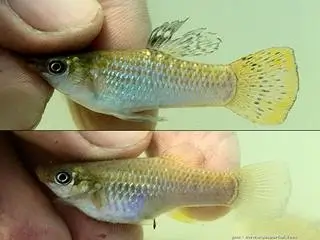 Molly pacifique
Molly pacifique
7,0 → 8,0 cm (> 200 L)
pH 7,0–8,0 | GH 5–20 | 23–27°C - Poecilia caucana
 Molly de Cauca
Molly de Cauca
3,0 → 6,0 cm (> 50 L)
pH 7,0–7,5 | GH 8–20 | 26–30°C - Poecilia chica
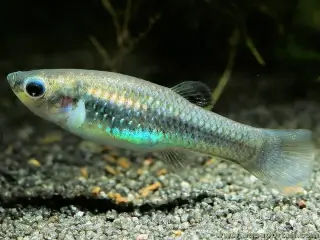 Molly nain
Molly nain
3,0 → 5,0 cm (> 50 L)
pH 6,5–7,5 | GH 5–15 | 22–26°C
- Poecilia hondurensis
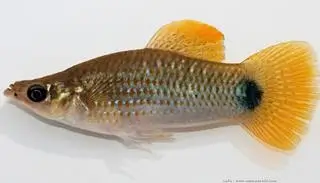
4,0 → 5,0 cm (> 80 L)
pH 7,0–7,5 | GH 8–20 | 24–28°C - Poecilia latipinna
 Molly lyre
Molly lyre
8,0 → 12,0 cm (> 120 L)
pH 7,0–8,5 | GH 10–30 | 21–29°C - Poecilia maylandi
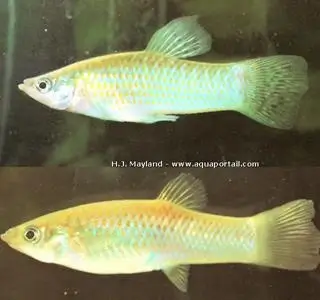 Molly de Mayland
Molly de Mayland
7,0 → 11,0 cm (> 200 L)
pH 7,5–8,5 | GH 15–30 | 24–28°C - Poecilia mexicana
 Molly taupe
Molly taupe
9,0 → 11,0 cm (> 300 L)
pH 7,0–7,5 | GH 15–30 | 22–28°C - Poecilia obscura
 Guppy de l'Oropuche
Guppy de l'Oropuche
1,5 → 3,0 cm (> 20 L)
pH 6,0–7,5 | GH 3–10 | 20–25°C - Poecilia orri
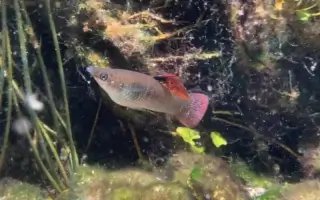 Molly des mangroves
Molly des mangroves
5,0 → 5,6 cm (> 80 L)
pH 7,5–8,5 | GH 15–30 | 22–26°C - Poecilia parae
 Guppy du Parà, Micropoecilia parae
Guppy du Parà, Micropoecilia parae
3,0 → 4,8 cm (> 80 L)
pH 7,0–8,0 | GH 5–20 | 23–29°C - Poecilia reticulata
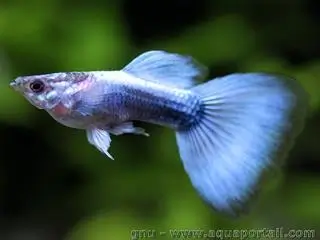 Guppy
Guppy
2,5 → 6,0 cm (> 50 L)
pH 6,0–8,0 | GH 3–30 | 20–28°C - Poecilia salvatoris
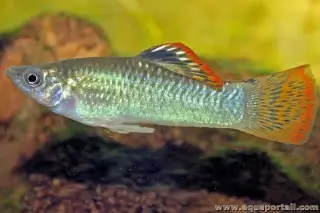 Molly de la liberté
Molly de la liberté
6,0 → 7,5 cm (> 120 L)
pH 7,0–8,0 | GH 8–20 | 22–25°C - Poecilia sphenops
 Molly
Molly
6,0 → 8,0 cm (> 120 L)
pH 7,0–8,5 | GH 10–30 | 18–28°C - Poecilia sulphuraria
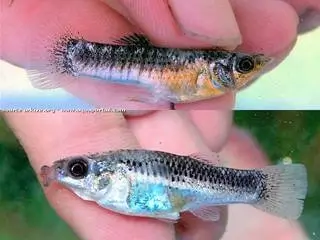 Molly soufre
Molly soufre
5,0 → 6,0 cm (> 80 L)
pH 7,0–8,0 | GH 15–30 | 24–28°C - Poecilia velifera
 Molly voile
Molly voile
14,0 → 17,0 cm (> 300 L)
pH 7,0–8,5 | GH 10–30 | 22–28°C - Poecilia vivipara

3,5 → 5,2 cm (> 50 L)
pH 7,0–8,5 | GH 10–30 | 24–29°C - Poecilia wingei
 Guppy Endler
Guppy Endler
2,0 → 4,0 cm (> 20 L)
pH 6,0–8,0 | GH 3–20 | 18–30°C - Poecilocharax weitzmani
 Tétra fouille-roche noirci, Tétra colibri
Tétra fouille-roche noirci, Tétra colibri
2,5 → 4,0 cm (> 50 L)
pH 5,0–6,5 | GH 1–5 | 24–28°C - Pollachius pollachius
 Lieu jaune
Lieu jaune
75,0 → 130,0 cm (> 6000 L)
pH 8,0–8,5 | GH | 0–0°C - Pollachius virens
 Lieu noir, colin noir
Lieu noir, colin noir
60,0 → 130,0 cm (> 6000 L)
pH 8,0–8,5 | GH | 2–15°C - Polycentrus schomburgkii
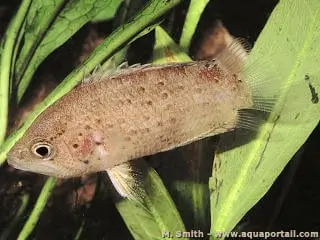 Poisson-feuille guyanais
Poisson-feuille guyanais
4,5 → 6,0 cm (> 20 L)
pH 6,0–7,0 | GH 8–15 | 22–26°C - Polypterus ansorgii

25,0 → 30,0 cm (> 450 L)
pH 6,0–7,0 | GH 3–15 | 23–28°C - Polypterus delhezi
 Bichir rayé
Bichir rayé
35,0 → 45,0 cm (> 1500 L)
pH 5,5–7,5 | GH 3–10 | 24–28°C - Polypterus senegalus meridionalis

60,0 → 70,0 cm (> 1500 L)
pH 6,0–8,0 | GH 3–20 | 25–28°C - Polypterus senegalus senegalus
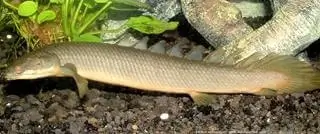 Bichir gris, Anguille dinosaure
Bichir gris, Anguille dinosaure
40,0 → 50,0 cm (> 800 L)
pH 6,0–8,0 | GH 3–20 | 25–28°C - Pomacanthus annularis
 Poisson-ange annelé
Poisson-ange annelé
35,0 → 45,0 cm (> L)
pH | GH | 23–28°C - Pomacanthus arcuatus
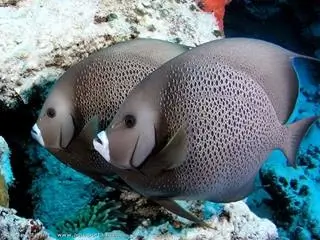 Poisson-ange blanc
Poisson-ange blanc
40,0 → 60,0 cm (> L)
pH | GH | 23–28°C - Pomacanthus asfur
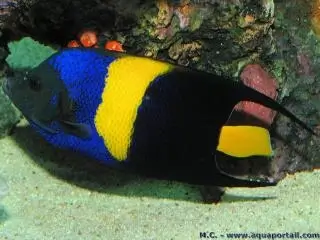 Poisson-ange demi-lune
Poisson-ange demi-lune
25,0 → 40,0 cm (> L)
pH | GH | 23–28°C - Pomacanthus chrysurus
 Poisson-ange à nageoire dorée
Poisson-ange à nageoire dorée
25,0 → 33,0 cm (> L)
pH | GH | 23–28°C - Pomacanthus imperator
 Poisson-empereur, Ange de mer impérial
Poisson-empereur, Ange de mer impérial
38,0 → 42,0 cm (> L)
pH | GH | 23–28°C - Pomacanthus maculosus
 Poisson-ange géographe
Poisson-ange géographe
35,0 → 50,0 cm (> 1500 L)
pH 8,0–8,5 | GH | 23–28°C - Pomacanthus navarchus
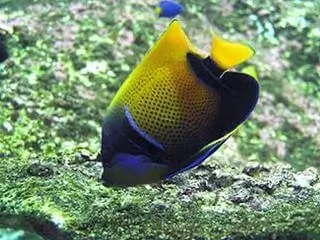 Poisson-ange amiral, Eventail du japon, Trompette du japon, Comtesse
Poisson-ange amiral, Eventail du japon, Trompette du japon, Comtesse
22,0 → 25,0 cm (> 450 L)
pH | GH | 23–28°C - Pomacanthus paru
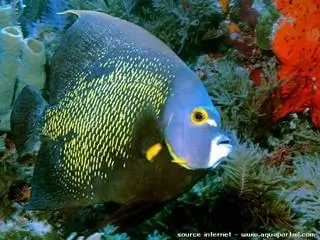 Poisson-ange Francais
Poisson-ange Francais
38,0 → 42,0 cm (> L)
pH | GH | 23–28°C - Pomacanthus rhomboides
 Poisson-ange vieille femme
Poisson-ange vieille femme
35,0 → 45,0 cm (> 1500 L)
pH | GH | 23–28°C - Pomacanthus semicirculatus
 Poisson-ange à demi-cercles
Poisson-ange à demi-cercles
33,0 → 37,0 cm (> L)
pH | GH | 23–28°C - Pomacanthus sexstriatus
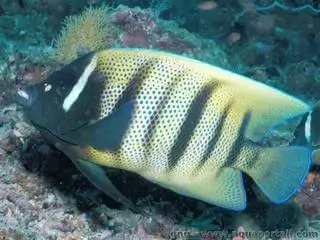 Poisson-ange à six bandes
Poisson-ange à six bandes
35,0 → 45,0 cm (> L)
pH | GH | 23–28°C - Pomacanthus xanthometopon
 Poisson-ange à tête bleue
Poisson-ange à tête bleue
30,0 → 40,0 cm (> 1500 L)
pH | GH | 23–28°C - Pomacanthus zonipectus
 Poisson-ange de Cortez
Poisson-ange de Cortez
43,0 → 47,0 cm (> 1500 L)
pH | GH | 23–28°C - Pomacentrus adelus
 Demoiselle obscure
Demoiselle obscure
7,0 → 8,5 cm (> L)
pH 8,0–8,5 | GH | 23–28°C
Les données biologiques des espèces indiquent la taille en cm et, si les valeurs sont pertinentes, d'autres caractéristiques spécifiques.
